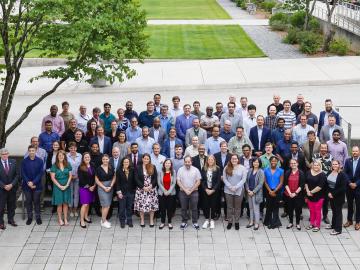
Filter News
Area of Research
- (-) Advanced Manufacturing (34)
- (-) Biology and Environment (177)
- (-) Fusion Energy (17)
- (-) National Security (80)
- Biological Systems (18)
- Biology and Soft Matter (5)
- Building Technologies (12)
- Chemical and Engineering Materials (4)
- Chemistry and Physics at Interfaces (11)
- Clean Energy (522)
- Climate and Environmental Systems (14)
- Computational Biology (6)
- Computational Chemistry (5)
- Computational Engineering (5)
- Computer Science (19)
- Data (1)
- Earth Sciences (1)
- Electricity and Smart Grid (3)
- Energy Frontier Research Centers (14)
- Energy Sciences (5)
- Fossil Energy (3)
- Fuel Cycle Science and Technology (3)
- Functional Materials for Energy (16)
- Fusion and Fission (54)
- Geographic Information Science and Technology (3)
- Isotope Development and Production (3)
- Isotopes (35)
- Materials (433)
- Materials Characterization (2)
- Materials for Computing (36)
- Materials Synthesis from Atoms to Systems (13)
- Materials Under Extremes (12)
- Mathematics (1)
- Neutron Data Analysis and Visualization (4)
- Neutron Science (190)
- Nuclear Science and Technology (74)
- Nuclear Systems Modeling, Simulation and Validation (3)
- Nuclear Systems Technology (1)
- Quantum Condensed Matter (4)
- Quantum information Science (9)
- Reactor Technology (1)
- Renewable Energy (4)
- Sensors and Controls (5)
- Supercomputing (311)
- Transportation Systems (11)
News Topics
- 3-D Printing/Advanced Manufacturing (35)
- Advanced Reactors (9)
- Artificial Intelligence (22)
- Big Data (15)
- Bioenergy (47)
- Biology (74)
- Biomedical (17)
- Biotechnology (13)
- Buildings (3)
- Chemical Sciences (12)
- Clean Water (11)
- Climate Change (43)
- Composites (8)
- Computer Science (39)
- Coronavirus (15)
- Critical Materials (1)
- Cybersecurity (20)
- Decarbonization (20)
- Energy Storage (8)
- Environment (91)
- Exascale Computing (5)
- Frontier (5)
- Fusion (15)
- Grid (9)
- High-Performance Computing (24)
- Hydropower (8)
- Isotopes (2)
- Machine Learning (20)
- Materials (19)
- Materials Science (15)
- Mathematics (3)
- Mercury (7)
- Microscopy (10)
- Molten Salt (1)
- Nanotechnology (8)
- National Security (35)
- Net Zero (2)
- Neutron Science (9)
- Nuclear Energy (17)
- Partnerships (9)
- Physics (3)
- Polymers (2)
- Quantum Science (1)
- Renewable Energy (1)
- Security (12)
- Simulation (14)
- Space Exploration (1)
- Summit (13)
- Sustainable Energy (38)
- Transformational Challenge Reactor (2)
- Transportation (5)
Media Contacts

When geoinformatics engineering researchers at the Department of Energy’s Oak Ridge National Laboratory wanted to better understand changes in land areas and points of interest around the world, they turned to the locals — their data, at least.

Experts across varied technology fields gathered ORNL to collaborate on the future of geospatial systems at the Trillion-Pixel GeoAI Challenge workshop. The third iteration of this event focused on multimodal advances in the field, including progress in artificial intelligence, cloud infrastructure, high-performance computing and remote sensing. These capabilities, when combined, can help solve problems in national and human security such as disaster response and land-use planning.

Oak Ridge National Laboratory researchers developed a model framework that identifies ways to ensure wildlife can safely navigate their habitats while not unduly affecting infrastructure.

Growing up exploring the parklands of India where Rudyard Kipling drew inspiration for The Jungle Book left Saubhagya Rathore with a deep respect and curiosity about the natural world. He later turned that interest into a career in environmental science and engineering, and today he is working at ORNL to improve our understanding of watersheds for better climate prediction and resilience.

With the world’s first exascale supercomputer now fully open for scientific business, researchers can thank the early users who helped get the machine up to speed.

Oak Ridge National Laboratory researchers recently demonstrated use of a laser-based analytical method to accelerate understanding of critical plant and soil properties that affect bioenergy plant growth and soil carbon storage.

Tristen Mullins enjoys the hidden side of computers. As a signals processing engineer for ORNL, she tries to uncover information hidden in components used on the nation’s power grid — information that may be susceptible to cyberattacks.

Creating energy the way the sun and stars do — through nuclear fusion — is one of the grand challenges facing science and technology. What’s easy for the sun and its billions of relatives turns out to be particularly difficult on Earth.

Scientist-inventors from ORNL will present seven new technologies during the Technology Innovation Showcase on Friday, July 14, from 8 a.m.–4 p.m. at the Joint Institute for Computational Sciences on ORNL’s campus.

Like most scientists, Chengping Chai is not content with the surface of things: He wants to probe beyond to learn what’s really going on. But in his case, he is literally building a map of the world beneath, using seismic and acoustic data that reveal when and where the earth moves.


